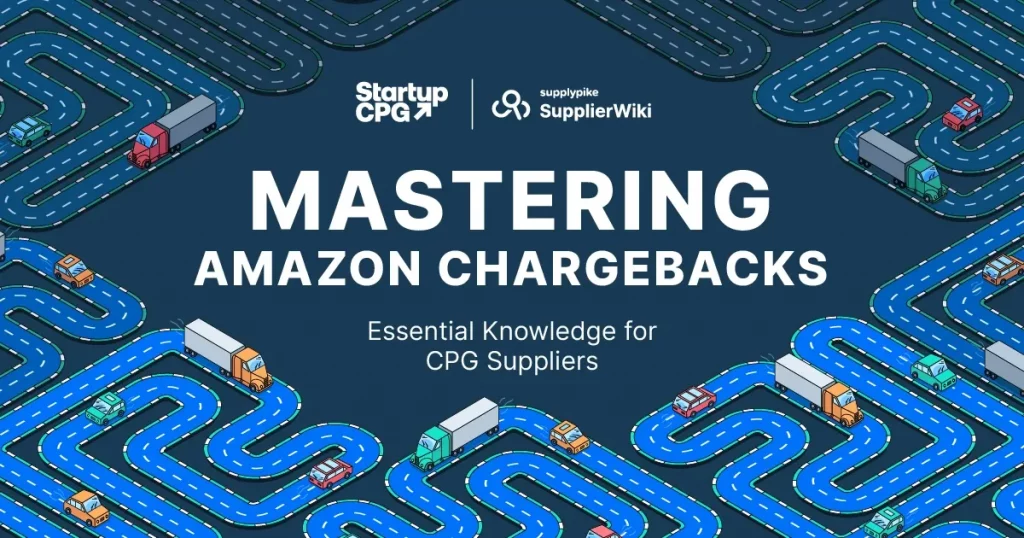Mastering Amazon Chargebacks:
Essential Knowledge for CPGs
What Are Amazon Chargebacks?
Working with any retailer requires suppliers to sign an agreement outlining the expectations both parties must adhere to. The requirements for orders to flow smoothly through a retailer’s supply chain vary by retailer, so it’s up to suppliers to adjust to a retailer’s process. When the expectations of the retailer, in this case, Amazon, are not met, the result is a chargeback.
Chargebacks are monetary fines meant to cover the expenses of non-compliance. At Amazon, suppliers may face a variety of chargeback types.
- Purchase order issues
- Receiving issues
- Packaging issues
- Delivery issues
- Advanced shipping notice (ASN) issues
- Transportation issues
Within the chargeback types, Amazon provides additional details as to why suppliers receive each chargeback. While chargebacks are frustrating, they aren’t all valid. Suppliers have the ability to dispute these chargebacks, and potentially be repaid.
Managing an Amazon Chargeback or Chargeback Fee
Amazon chargebacks are tough to avoid altogether. The best method for vendors to prevent chargebacks is to clearly understand Amazon’s compliance expectations. If you need help with one of these specific chargeback areas, take a look at the brief troubleshooting tips for each of the chargeback categories.
Purchase Order Issues
Merchants can avoid PO-related chargebacks by shipping orders within the 12-hour shipping window. This will ensure orders run through the fulfillment centers on time.
Packaging Issues
Merchants can consult with the distribution center to see if there is a packaging issue. Merchants should invest in frustration-free packaging to limit possible Amazon chargebacks.
Inform the vendor of Amazon’s Packing Certification Guidelines as well.
ASN Issues
The ASN must get sent before the purchase order shipment gets scanned at the fulfillment center. The ASNs can get sent in manually through Vendor Central.
Delivery Issues
Delivery issues often are the result of missing appointed delivery times. With delivery compliance, proactive communication is pertinent.
If you cannot accommodate the scheduled pickup, you must change the pickup date by 5:00 p.m. PT on the day before the scheduled pickup to prevent this defect.
Receiving Issues
Inventory that is mislabeled, set up incorrectly, or has issues with the barcodes creates bottlenecks when received at Amazon’s fulfillment centers. Check these key areas that often create a myriad of problems with your Amazon supply chain.
Handling an Amazon Chargeback
Vendors have two options when notified regarding an Amazon chargeback; accept or dispute the chargeback claim.
To respond to a chargeback, the vendor will need to respond to the notification within the Operational Performance Report found on Vendor Central under the Reports tab.
The first part of disputing a chargeback is understanding why it was issued by Amazon. After reviewing Amazon’s performance tips, details of the claim, and finding evidence that the claim is invalid, the vendor should move forward with the dispute. Vendors have 30 calendar days from the initial notification to respond, or the PO’s chargeback will automatically be charged to the vendor.
Accepting an Amazon Chargeback
Accepting the chargeback will require full repayment from the vendor to Amazon.
Sometimes it is in your best interest to accept the Amazon chargeback. Your team may find that the charge was valid and correct the issue(s) to avoid future fines. Your team may need more time, labor, or skill to research chargeback claims.
The amount associated with each chargeback will also vary, depending on the PO, chargeback types, and cases affected. Strategize with your team on which fines are worth going after; and which are sunk costs.
Dispute a Chargeback
Responding to a chargeback starts with collecting information that supports the vendor. Relevant documents will increase the chance of a successful dispute.
Through Operational Performance, vendors have access to information related to the chargeback.
- Chargeback types
- The amount charged by chargeback type
- Contributing ASIN(s)
- Contributing PO(s)
- Details outlining the chargeback
- Performance Tips to assist in correcting the chargeback
Amazon agents conduct internal investigations once the vendor has filled in the required information. They may reach out for additional information. With Amazon, suppliers only have one shot to win the dispute within 30 days. After that, Amazon has said that suppliers can redispute once more. This second dispute attempt is usually only successful if the supplier has additional relevant information. Examples of this may include:
- Order confirmation
- Photos of the item
- The return and refund policies of the merchant
- Communication records with the customer
The investigation for a chargeback claim can take up to 90 days. Only after the examination gets completed will the vendor get charged or not. The merchant gets charged the chargeback amount from your account.
Amazon Chargebacks Conclusion
Amazon chargebacks will happen to all suppliers doing business with the eCom giant.
Merchants can navigate Amazon chargebacks by first thoroughly understanding Amazon’s supplier requirements. Other best practices include maintaining records of communication with your Amazon partners.
Respond to Amazon quickly to work through your chargeback as soon as possible. Be patient and understand that chargebacks happen to all merchants.
For more information about Amazon Deductions or Chargebacks, check out our free, exhaustive guide, Amazon Deductions Explained.
Also, sign up for our newsletter at SupplierWiki. The free, educational platform for CPG suppliers, Supplierwiki, is created by industry experts for industry experts. Check out the articles, webinars, and other resources available today.






All Comments